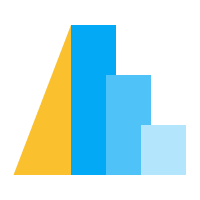Error Band#
An error band summarizes an error range of quantitative values using a set of summary statistics, representing by area. Error band in Altair can either be used to aggregate raw data or directly visualize aggregated data.
To create an error band, use mark_errorband.
Error Band Mark Properties#
An errorband mark definition can contain the following properties:
Click to show table
Property |
Type |
Description |
|---|---|---|
extent |
The extent of the band. Available options include:
Default value: |
|
orient |
Orientation of the error band. This is normally automatically determined, but can be specified when the orientation is ambiguous and cannot be automatically determined. |
|
color |
Default color. Default value: Note:
|
|
opacity |
|
The opacity (value between [0,1]) of the mark. |
interpolate |
The line interpolation method for the error band. One of the following:
|
|
tension |
|
The tension parameter for the interpolation type of the error band. |
Besides the properties listed above, band and borders can be used to specify
the underlying mark properties for different parts of the error band as well.
Comparing the usage of Error Band to the usage of Error Bar#
All the properties and usage of error band are identical to error bar’s, except the band and borders that replace the error bar’s rule and ticks.
Error Band
import altair as alt
from altair.datasets import data
source = data.cars.url
alt.Chart(source).mark_errorband(extent="ci", borders=True).encode(
x="year(Year)",
y=alt.Y(
"Miles_per_Gallon:Q",
scale=alt.Scale(zero=False),
title="Miles per Gallon (95% CIs)",
),
)
Error Bar
import altair as alt
from altair.datasets import data
source = data.cars.url
alt.Chart(source).mark_errorbar(extent="ci", ticks=True).encode(
x="year(Year)",
y=alt.Y(
"Miles_per_Gallon:Q",
scale=alt.Scale(zero=False),
title="Miles per Gallon (95% CIs)",
),
)
Using Error Band to Aggregate Raw Data#
If the data is not aggregated yet, Altair will aggregate the data based on the extent properties in the mark definition as done in the error band showing confidence interval above. All other extent values are defined in Error Bar.
Using Error Band to Visualize Aggregated Data#
1. Data is aggregated with low and high values of the error band
If the data is already pre-aggregated with low and high values of the error band, you can directly specify x and x2 (or y and y2) to use error band as a ranged mark.
import altair as alt
import pandas as pd
source = pd.DataFrame(
{
"ci1": [23.5007, 25.8214, 26.4472, 27.7074],
"ci0": [19.6912, 20.8554, 21.9749, 22.6203],
"center": [21.5735, 23.3750, 24.0611, 25.0931],
"Year": [189302400000, 220924800000, 252460800000, 283996800000],
}
)
band = alt.Chart(source).mark_errorband().encode(
alt.Y(
"ci1:Q",
scale=alt.Scale(zero=False),
title="Mean of Miles per Gallon (95% CIs)"
),
alt.Y2("ci0:Q"),
alt.X("year(Year)"),
)
line = alt.Chart(source).mark_line().encode(
alt.Y("center:Q"),
alt.X("year(Year)")
)
band + line
2. Data is aggregated with center and error value(s)
If the data is already pre-aggregated with center and error values of the error band, you can use x/y, x/yError, and x/yError2 as defined in Error Bar.
Dimension#
Altair supports both 1D and 2D error bands:
A 1D error band shows the error range of a continuous field; it can be used to show the global error range of the whole plot.
import altair as alt
from altair.datasets import data
source = data.cars.url
band = alt.Chart(source).mark_errorband(extent="stdev").encode(
alt.Y("Miles_per_Gallon:Q").title("Miles per Gallon")
)
points = alt.Chart(source).mark_point().encode(
x="Horsepower:Q",
y="Miles_per_Gallon:Q",
)
band + points
A 2D error band shows the error range of a continuous field for each dimension value such as year.
import altair as alt
from altair.datasets import data
source = data.cars()
line = alt.Chart(source).mark_line().encode(
x="Year",
y="mean(Miles_per_Gallon)"
)
band = alt.Chart(source).mark_errorband(extent="ci").encode(
x="Year",
y=alt.Y("Miles_per_Gallon").title("Miles/Gallon"),
)
band + line
Color and Opacity Encoding Channels#
You can customize the color and opacity of the bands by using the color and opacity encoding channels.
Here is an example of a errorband with the color encoding channel set to alt.value('black').
import altair as alt
from altair.datasets import data
source = data.cars.url
alt.Chart(source).mark_errorband(extent="ci", borders=True).encode(
x="year(Year)",
y=alt.Y("Miles_per_Gallon:Q")
.scale(zero=False)
.title("Miles per Gallon (95% CIs)"),
color=alt.value("black")
)
